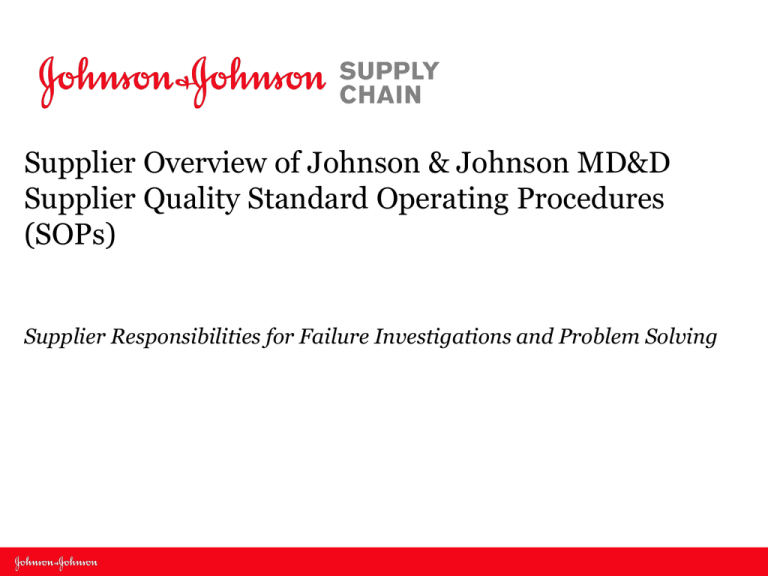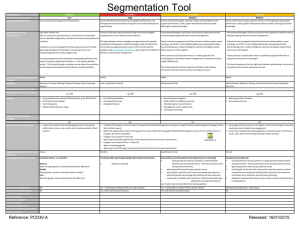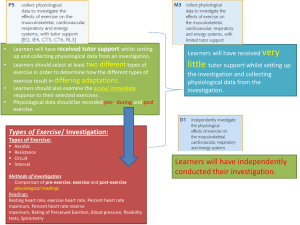The Supplier Failure Investigation and Problem Solving Template
advertisement

Supplier Overview of Johnson & Johnson MD&D Supplier Quality Standard Operating Procedures (SOPs) Supplier Responsibilities for Failure Investigations and Problem Solving Purpose of this SOP • Establishes the process for failure investigations and problem solving activities conducted by suppliers • Applies to CAPAs, nonconformances, SCARs (Supplier Corrective Action Requests), etc. • A Supplier Failure Investigation and Problem Solving Template is provided 2 Scope of Supplier Failure Investigation SOP • Begins when a supplier has been notified of an issue (nonconformance, CAPA, etc.) • Ends when the supplier has completed all activities agreed to with MD&D to execute and document the failure investigation and problem solving associated with an issue • Links supplier Failure Investigation (FI) and Problem Solving (PS) activities with the overall MD&D expectations for Failure Investigation and Problem Solving Overall MD&D FI/PS Expectations MD&D Supplier FI/PS SOP Supplier FI/PS Activities 3 Key Definitions • Correction - Action to eliminate a detected nonconformity. A repair, modification, adjustment, relabeling, destruction or inspection of a product or process. • Corrective Action - Action to eliminate or reduce the cause or effect of a detected nonconformity or other undesirable situation, in order to prevent recurrence. • Preventive Action - Action to eliminate or reduce the cause or effect of potential nonconformity, defect or other undesirable situation, in order to prevent occurrence. Consistent with existing internal MD&D expectations, but now making sure the definitions are consistently integrated into supplier failure investigation activities 4 Responsibilities MD&D • Ensure SOP requirements are met (in procedures & by suppliers) • Notify the supplier of identified issues (nonconformance, CAPAs) • Complete and document the full failure investigation (incorporating the supplier response) in the appropriate system Suppliers • Conduct and document the supplier failure investigation and problem solving activities for supplier related issues • Provide the information and/or template as requested by the MD&D Operating Company that requested the failure investigation 5 Key Requirements • Suppliers to use MD&D form, if specified ―SOP allows for Op Co or supplier forms ―Template provided with the SOP can be used or can act as a guide ―MD&D form has definitions and walks you through the process • MD&D notification of issues to suppliers ―Requirements for supplier notification are detailed in the SOP ―Timing requirements/deadlines still determined by each Op Co 6 Supplier Failure Investigation and Problem Solving Process • Problem Statement / Supplier notification • Bounding and containment ―Preliminary cause analysis (rationale for bounding) • Corrections • Root cause • Plan corrective/preventive actions & effectiveness monitoring • Execute the plan and document actions taken • Monitor effectiveness Drives suppliers to approach failure investigation and problem solving in a similar fashion to J&J MD&D 7 Problem Statement & Bounding/Containment • Process starts with a good Problem Statement ―Clearly and factually describe the current condition as compared to the “should-be” condition ―Measureable (how often, how much, when, where) and fact-based ―Typically provided by MD&D (supplier can update) • Supplier to conduct bounding and containment ―Locating and segregating suspect/nonconforming material at all locations (supplier, sub-tiers, alternate sites, etc.) ―Broad based approach identifying product that may be impacted ―Should be based on Preliminary Cause Analysis (PCA provides a rationale for bounding) 8 Preliminary Cause Analysis • Extent of bounding should be based on Preliminary Cause Analysis (PCA) - provides rationale for bounding • PCA is essentially the start of root cause identification • Output of PCA is an understanding of potential causes, which can be used to establish bounding Tools, such as 5-Why, should be used 9 Corrections • Corrections: Documented action taken to eliminate and/or rework, repair, or a contain a detected nonconformity(s) and to document the final product disposition • Root cause not required for correction, rather it focuses on ensuring that the defects in question are properly controlled • Any new controls/rework should be evaluated for the need to be verified or validated • Corrections can have unintended consequences (e.g. removing burrs can result in foreign matter/contamination) The SOP and template are intended to aid suppliers in understanding the differences between Correction and Corrective Action 10 Root Cause Identification • Continuation of any Preliminary Cause Analysis activities • Document the root cause(s) that if corrected prevents reoccurrence of the same event. If root cause not confirmed then identify probable cause. • Provide a rationale for root cause selection ―Whenever possible, this can be accomplished by confirming the selected root cause turns the issue on/off ―Identify and attach tools used, such as 5-Why • In most cases training or human error is not the root cause • After root cause identification, ensure bounding is still appropriate • Identify any controls that were not effective 11 Planning Corrective and Preventive Actions • Establish planned corrective and/or preventive actions ― Who, what, when • Corrective actions prevent recurrences by eliminating causes. Corrective Action is designed to prevent the recurrence of nonconformities/issues. • While corrective actions prevent recurrence, preventive actions prevent occurrence (to prevent the occurrence of situations that do not yet exist) ― Don’t just think of the single part, product, process or plant • Where applicable, plan to update FMEAs and control plans • Training should typically not be the only corrective action • Document an effectiveness monitoring plan if needed (based on franchise CAPA/NC procedures; see SOP for details) Additional CA/PA planning details are provided in the SOP 12 Execute and Document Actions Taken • Carry out and document actions per established timing • Notify MD&D of any changes to the plan • Verify/validate per Op Co procedures • Provide summary of investigation/activities and evidence • Monitor/document effectiveness as defined in the plan ―If not effective, continue with the Failure Investigation process 13 Supplier Failure Investigation and Problem Solving Template The Supplier Failure Investigation and Problem Solving Template walks the user through the failure investigation process 14 Supplier Failure Investigation and Problem Solving Template The template includes definitions for key terms and can be used as a process guide even if an alternate form is being used 15 Supplier Failure Investigation and Problem Solving Template Planned actions and problem solving progress can be documented in the Supplier Failure Investigation Template 16











